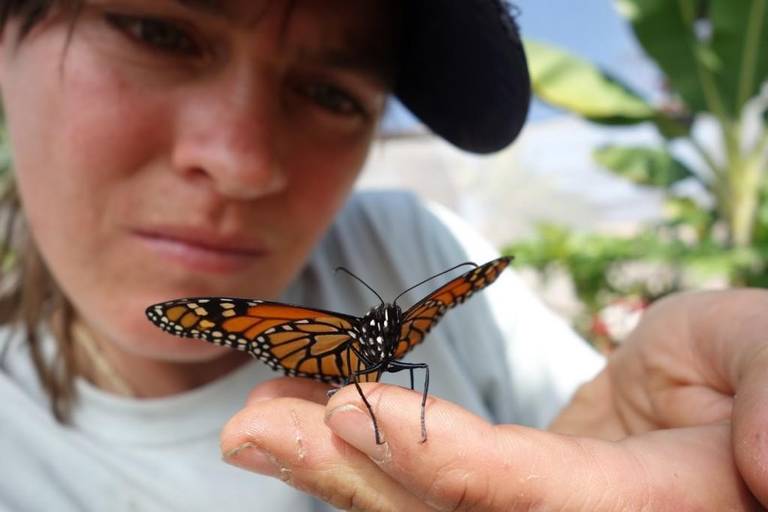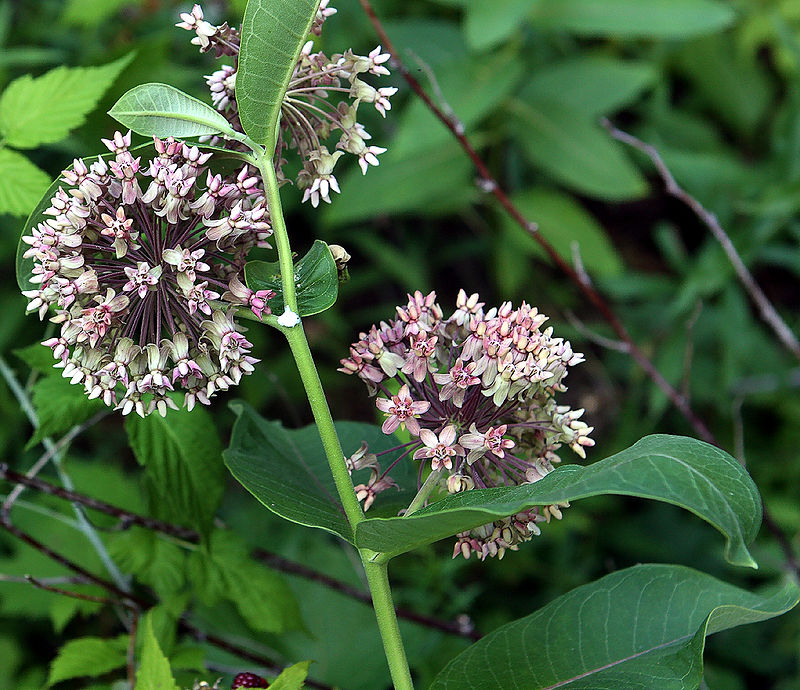


HSU alum Sarah Dykman is currently on a 10,000 mile bike trip for butterflies
Sara Dykman is an adventurer.
She’s hiked the length of the Continental Divide, canoed the length of the Missouri River and biked nearly 10,000 miles from the snow-capped Andes in Bolivia through tropical forests and deserts into Texas.
Typically the 32-year-old Johnson County native sets out with like-spirited companions.
This time, those companions number in the millions, plus they’re orange.
“I’m not biking solo,” Dykman said, stopping briefly from her pedaling to talk on her cell phone from a spot about 100 miles south of Kansas City. “I’m biking with millions of monarchs (the butterflies). But I’m the only person.”
Dykman, who is scheduled to stop and speak at schools in Kansas City next week, has a simple yet dual mission.
The first is to live life immersed in nature’s grandeur in a way that few ever do.
Dykman owns no car or house. She doesn’t do this for money and has no financial sponsors. Schooled at Westwood View Elementary, then Indian Hills Middle, then Shawnee Mission East High School (class of 2004),
Dykman went on to earn her bachelor’s degree in biology at California’s Humboldt State University.

Her modus operandi is to work, make a few dollars here and there doing field biology projects, and then set forth on adventures that, as she travels on foot or bike or canoe, cost her no more than about $10 a day. In some ways,
she said, she is just living life in reverse.
“I tell people I’m retired now,” Dykman said, meaning while she’s still young and healthy. Plenty of time for work later. “I figure I’ll have to work until I’m 90,” she said, laughing.
On this adventure, her other goal is to call attention to the plight of monarch butterflies, which, taking flight on orange and black wings, every year embark on what she and others judge to be one of nature’s most wondrous cross-country migrations.
“There really isn’t a more interesting migration on the planet, I would say,” Dykman said. “The migration is incredible to me.”
In the warmth of the summer, monarchs can be found throughout the United States, with their range extending as far north as Winnipeg, Canada. But beginning in late August, as the autumn begins to approach in the north, tens of millions of the butterflies take wing.
Monarchs living in states east of the Rocky Mountains, including Missouri and Kansas, will travel hundreds of miles —and for those in Canada, up to 3,000 miles over more than two months — to a tiny area now known as the Monarch Butterfly Biosphere Reserve in the mountains northwest of Mexico City. (A much smaller population of monarchs west of the Rockies travel to areas in Southern California.)
In Mexico, those tens of millions of butterflies will live not far from the city of Angangueo in the state of Michoacán. They fill the sky and cluster so heavily on oyamel fir trees that their branches look as if they are covered with orange and black leaves.
Equally astounding is the spring migration back as the weather turns warms. Usually beginning in early March, the same butterflies that flew to Mexico will begin to head back north, breeding and laying eggs on vital milkweed plants along the way. The original butterflies die out not long after breeding. It’s up to the subsequent generations, whose caterpillars feed on the milkweed plant, that will make the rest of the journey north or stay in the warmer climes to continue breeding.

Major problem: Over the last 20 years, tens of millions of acres of milkweed plants have been plowed under to farming or uprooted by development. The result has been the loss of some 95 percent of the monarch butterfly population, prompting many federal and state conservation authorities to search for answers.
In 1996, the annual monarch count had reached what was even then an unusual peak of nearly 1 billion butterflies. More recent counts have them at about 50 million.
Dykman left Mexico in March just as the butterflies were venturing north to breed in Texas. In the last two months, she’s already traveled some 2,200 miles, her mountain bike laden with four saddlebags for her tent, sleeping bag, tin can stove, clothes, laptop and camera.
She’s traveled through rain, over hills and prairie flats, stopping occasionally to give a talk on the butterflies — urging kids and adults to plant more milkweed in their gardens — to keep the beautiful insects from disappearing.
“We literally can share out backyards with them,” Dykman said.
Orley “Chip” Taylor, director of Monarch Watch, a nonprofit based in Lawrence, is glad Dykman is out there. She is scheduled to speak at Monarch Watch, 2021 Constant Ave. on the West Campus of the University of Kansas, on Saturday, May 13. The organization will be selling thousands of milkweed plants at its spring open house from 8 a.m. to 2 p.m. that day as part of a fundraiser.
“I like what Sara is doing,” said Taylor, 79, who said he consulted with her on what might be the best Monarch
route to follow. “I think Sara is personalizing this mission in a way that few of us can. No way I’m getting on a bike at my age traveling around the world. I applaud her efforts.”

The loss of milkweed is so extensive, Taylor said, that many states are now trying to put together planting plans to counter the loss. A proposal of Taylor’s own is to create what he called a “milkweed highway” by cultivating the plants in the median and other areas along highways from Mexico to Canada.
“The bottom line is we need to plant a lot of milkweed, we need to produce 1.4 billion stems back on the
landscape. That’s billion with a B,” Taylor said. “That’s a big order. I should tell you that every state in the Midwest is trying to come up with a monarch conservation plan.”
Taylor said this has already been an unusual year for the Monarchs because of the way strong April winds pushed the first wave of butterflies much farther north than they normally are by now. The butterflies are flying into areas that have little milkweed as of yet, forcing them to lay multiple eggs on a limited number of plants that can’t support them. Taylor called it “egg dumping.”
“We have rescued about 500 caterpillars where milkweed is just popping out of the ground,” he said. “Right here in Lawrence.”
Another wave of the butterflies, hatched from the first breeding in Texas, will likely get to the Kansas City area in mid-May, certain to catch up with Dykman, who next week will be doing her part.
She is scheduled to appear at Hale Cook Elementary in Kansas City for its Garden Day on Sunday; Timber Creek Elementary in Overland Park and Indian Creek Elementary in Olathe on Monday; Frank Rushton Elementary School in Kansas City, Kan., on Tuesday; Tomahawk Elementary in Overland Park on Wednesday; and Merriam Park Elementary in Merriam on Thursday.
She posts pictures and videos of this trip, which she called ButterBike, as well as others, on her website, beyondabook.org, where some people also donate to her effort.
Just as good people plant milkweed for the butterflies, similar people tend to help Dykman on her migration as well, offering her a free meal every now and then, a shower or a place to stay.
After Kansas City and Lawrence, Dykman will head north, up through Iowa and Minnesota, and then east, across upper Wisconsin and toward Canada. She expects to get to Montreal sometime in June. In July, she will start peddling back, with a stop again in Kansas City probably in November. “The whole route is 10,000 miles,” Dykman said, knowing how that sounds.
“It’s crazier,” she said, “that a butterfly does it.”
Story by Eric Adler
Read more here: http://www.kansascity.com/news/local/article148599379.html#storylink=cpy
And here: http://www.humboldt.edu/